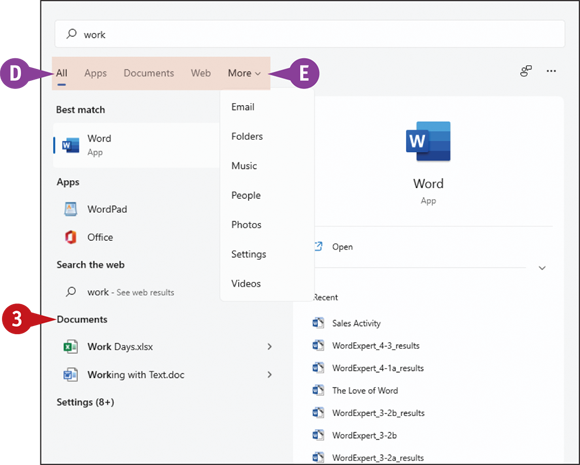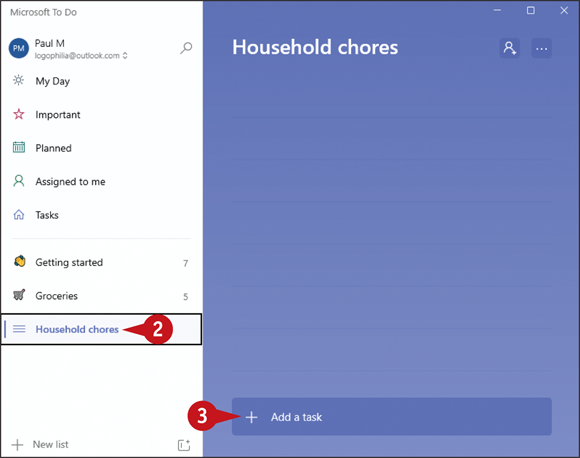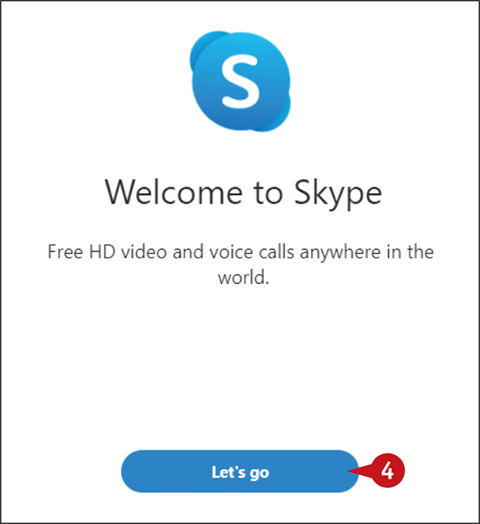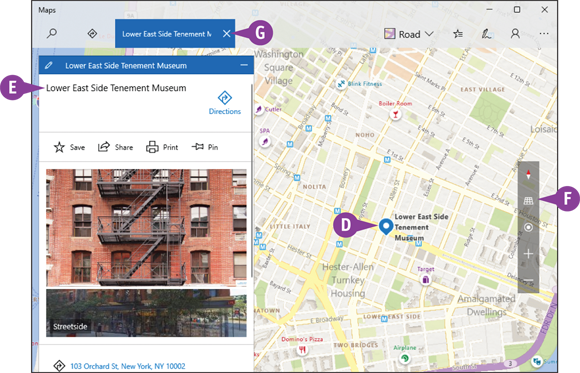CHAPTER 6
Performing Day-to-Day Tasks with Apps
You can use the apps that come with Windows to perform many useful day-to-day tasks. For example, rather than looking through menus and folders to find apps, settings, and files, you can search for them. Other useful tasks you can perform with Windows are writing a note, making a to-do-list, setting up and using Skype to make video calls, viewing locations on a map, getting turn-by-turn directions from your current location to a destination you specify, and looking up your local weather forecast and forecasts in other cities.

Search Your PC
After you have used your PC for a while and have created many documents, you might have trouble locating a specific file. You can save a great deal of time by having Windows search for your document.
You can use the Search feature to look for apps, system settings, and documents on your PC, as well as websites on the Internet. If you are working with File Explorer, you can also perform document searches using the Search box in a folder window.
Search Your PC

Search from the Taskbar
![]() Click Search (
Click Search (![]() ).
).
![]() Click inside the Search box and type your search text.
Click inside the Search box and type your search text.
![]() Windows displays the top apps, settings, and documents with names that include your search text.
Windows displays the top apps, settings, and documents with names that include your search text.
![]() Windows displays other search results here, organized by category (such as Documents).
Windows displays other search results here, organized by category (such as Documents).
![]() If you see the app, setting, or document that you want, you can click it.
If you see the app, setting, or document that you want, you can click it.

![]() To see results from a specific category, click a heading, such as Documents.
To see results from a specific category, click a heading, such as Documents.
![]() You can also click a category.
You can also click a category.
![]() You can click the More
You can click the More ![]() to see extra categories, as shown here.
to see extra categories, as shown here.
Windows displays the category items that match your search text.

![]() Windows displays details and related tasks for the selected search item here.
Windows displays details and related tasks for the selected search item here.
![]() Click the item you want.
Click the item you want.
Windows opens the app, setting, document, or website.

Search from a Folder Window
![]() Click File Explorer (
Click File Explorer (![]() ).
).
![]() Open the folder you want to search.
Open the folder you want to search.
![]() Type your search text in the Search box.
Type your search text in the Search box.
![]() As you type, Windows displays the folders and documents in the current folder with names, contents, or keywords that match your search text.
As you type, Windows displays the folders and documents in the current folder with names, contents, or keywords that match your search text.
![]() If you see the folder or document that you want, double-click it.
If you see the folder or document that you want, double-click it.
The folder or document opens.
Write a Note
You can use the Notepad app to create simple text documents for things such as to-do lists and meeting notes. Word processing programs such as WordPad, as well as powerful note-taking apps such as the OneNote app covered in Chapter 9, are useful for creating complex and lengthy documents, but they feel like overkill when all you want to do is jot down a few simple notes. For these more basic text tasks, the Notepad app that comes with Windows is perfect because it offers a simple interface that is easy to learn and use.
Write a Note

Start Notepad
![]() Click Start (
Click Start (![]() ).
).
The Start menu appears.
![]() Click All apps.
Click All apps.

![]() Click Notepad.
Click Notepad.

Notepad opens.
Write and Save a Note
![]() Type your note text.
Type your note text.
![]() Click File.
Click File.
![]() Click Save.
Click Save.

The Save As dialog box appears.
![]() Select the folder in which you want to save the file.
Select the folder in which you want to save the file.
![]() Type a name for the file.
Type a name for the file.
![]() Click Save.
Click Save.
Notepad saves the file.
Make a To-Do List
You can use the Microsoft To Do app to set up an electronic to-do list that enables you to keep track of tasks you have to perform or items you want to remember. The To Do app comes with several ready-to-use lists, but you can also create your own lists to track items such as household chores, goods to purchase, project tasks, trip preparation, and more. You can also get the To Do app to remind you when a task is due, and you can set up tasks that repeat at regular intervals.
Make a To-Do List

Start Microsoft To Do
![]() Click Start (
Click Start (![]() ).
).
The Start menu appears.
![]() Click To Do.
Click To Do.

![]() If your version of Windows does not have the To Do app pinned to the Start menu, you can click All apps and then click To Do.
If your version of Windows does not have the To Do app pinned to the Start menu, you can click All apps and then click To Do.
The To Do app opens.
Create and Populate a New To-Do List
![]() Click New list.
Click New list.

![]() Rather than creating a new list, you can instead click one of the To Do app’s predefined lists and then skip to step 4.
Rather than creating a new list, you can instead click one of the To Do app’s predefined lists and then skip to step 4.
To Do creates a new list and prompts you for a title.
![]() Type the list title and press
Type the list title and press ![]() .
.
![]() Click Add a task.
Click Add a task.

To Do creates a new task.
![]() Type the task description and then press
Type the task description and then press ![]() .
.
To Do adds the tasks and then creates a new task.
![]() Repeat step 4 until your list is complete.
Repeat step 4 until your list is complete.
Note: When you complete a task, click the task’s Complete button (![]() changes to
changes to ![]() ).
).
Configure Skype
You can use the Skype app to place calls to friends and family using your Internet connection. Unlike regular phone calls, Skype lets you place video calls, which means you hear and see the other person. If either you or the person you call does not have a video camera, then Skype also enables you to place voice calls over the Internet.
Although you can sign up for a Skype account separately, this is not necessary because Windows assigns you a Skype account automatically using your Microsoft account. This section assumes you are using a Microsoft account (see Chapter 1).
Configure Skype

![]() Click Search (
Click Search (![]() ).
).
![]() Type skype.
Type skype.
![]() Click Skype.
Click Skype.

The Welcome to Skype screen appears.
![]() Click Let’s go.
Click Let’s go.
![]() If you have multiple Microsoft accounts, the Sign in With screen appears (not shown). Click the account you want to use with Skype.
If you have multiple Microsoft accounts, the Sign in With screen appears (not shown). Click the account you want to use with Skype.

The Choose Your Profile Picture screen appears.
Note: If you see the Update Your Profile Picture screen instead, you can skip to step 7 if you do not want to change your profile picture.
![]() Click Upload Photo, use the Open dialog box (not shown) to select a photo, and then click Open.
Click Upload Photo, use the Open dialog box (not shown) to select a photo, and then click Open.
![]() Click Continue.
Click Continue.

The Test Your Audio screen appears.
![]() Speak normally into your PC’s microphone.
Speak normally into your PC’s microphone.
Skype automatically adjusts the microphone volume as you speak.
![]() Click Continue.
Click Continue.
Skype displays your PC’s camera feed.
![]() Click Continue (not shown).
Click Continue (not shown).
The Find Contacts Easily screen appears.
![]() Click Go (not shown).
Click Go (not shown).
Skype completes the configuration and displays its main window.
Call Someone Using Skype
Once you have Skype set up on your PC, as described in the previous section, “Configure Skype,” you are ready to make and accept video calls. When you make a call, note that the other person has to accept the call before the conversation can begin. Similarly, when someone calls your PC, you can either accept or decline the incoming call. This means you do not have to answer a call if you are too busy or otherwise occupied.
Call Someone Using Skype

Initiate a Call
![]() Click the Calls tab.
Click the Calls tab.

![]() Click the name of the person you want to call.
Click the name of the person you want to call.
![]() If your list of Skype contacts is long, you can use this Search box to type the name of the person you want to call.
If your list of Skype contacts is long, you can use this Search box to type the name of the person you want to call.

![]() Click the type of call you want to make:
Click the type of call you want to make:
![]() You can click Video Call (
You can click Video Call (![]() ) to make a video call.
) to make a video call.
![]() You can click Audio Call (
You can click Audio Call (![]() ) to make a voice call.
) to make a voice call.

Accept a Call
![]() This bar appears when Skype detects an incoming call.
This bar appears when Skype detects an incoming call.
![]() Click Video (
Click Video (![]() ).
).
![]() If you want to use voice only, you can click Audio (
If you want to use voice only, you can click Audio (![]() ), instead.
), instead.
![]() To decline the call, you can click Decline (
To decline the call, you can click Decline (![]() ).
).
![]() When you are finished with the call, click the Skype window to display the controls, and then click End Call (
When you are finished with the call, click the Skype window to display the controls, and then click End Call (![]() ) (not shown).
) (not shown).
Display a Location on a Map
You can use the Maps app to display a location on a map. Maps is an app that displays digital maps that you can use to view just about any location by searching for an address or place name.
When you first start the Maps app, Windows asks if it can turn on location services, which are background features that help determine your current location and offer this information to apps such as Maps. For the best results with Maps, you should allow Windows to turn on location services.
Display a Location on a Map

![]() Click Search (
Click Search (![]() ).
).
![]() Type maps.
Type maps.
![]() Click Maps.
Click Maps.

The Maps window appears.
![]() In the Navigation toolbar, you can click Zoom in (
In the Navigation toolbar, you can click Zoom in (![]() ) and Zoom out (
) and Zoom out (![]() ) to see more or less map detail.
) to see more or less map detail.
![]() You can click Show my location (
You can click Show my location (![]() ) to see your current location.
) to see your current location.

![]() Type the address or the name of the location.
Type the address or the name of the location.
![]() Click the location in the search results.
Click the location in the search results.
![]() To see a list of matching locations, you can click Search (
To see a list of matching locations, you can click Search (![]() ) and then click the location you want.
) and then click the location you want.

![]() Maps displays the location on the map.
Maps displays the location on the map.
![]() Maps displays information about the location.
Maps displays information about the location.
![]() You can click Tilt (
You can click Tilt (![]() ) to tilt the map vertically.
) to tilt the map vertically.
![]() You can click Close (
You can click Close (![]() ) to hide the location information.
) to hide the location information.
Get Directions to a Location
Besides displaying locations, Maps also recognizes the roads and highways found in most cities, states, and countries. This means that you can use the Maps app to get specific directions for traveling from one location to another.
You specify a starting point and destination for a trip, and Maps then provides you with directions for getting from one point to the other. Maps highlights the trip route on a digital map and gives you specific details for negotiating each leg of the trip.
Get Directions to a Location

![]() Click Directions (
Click Directions (![]() ).
).
![]() The Map Views list appears (see the tip in this section).
The Map Views list appears (see the tip in this section).

![]() Click the travel method: Driving (
Click the travel method: Driving (![]() ), Transit (
), Transit (![]() ), or Walking (
), or Walking (![]() ).
).
Note: Maps assumes that you want to start at your current location. If that is true, skip step 3.
![]() Type the name or address of the location where your journey will begin.
Type the name or address of the location where your journey will begin.
![]() Type the name or address of your destination.
Type the name or address of your destination.
![]() Click Get directions.
Click Get directions.

![]() Maps displays overviews of the available routes.
Maps displays overviews of the available routes.
![]() These boxes show the distance and approximate traveling time for each route.
These boxes show the distance and approximate traveling time for each route.
![]() Click Go for the route you want to take.
Click Go for the route you want to take.

Maps zooms in on the route.
![]() Maps displays the route instructions here.
Maps displays the route instructions here.
![]() Maps tells you how much time and distance are remaining to your destination.
Maps tells you how much time and distance are remaining to your destination.
Note: As you travel along the route, the instructions and the remaining time and distance change accordingly.
Check Your Weather Forecast
You can use the Weather app to view your city’s current conditions and five-day forecast. The Weather app takes advantage of several online weather resources to obtain up-to-the-minute conditions and forecasts.
The Weather app can check the forecast for a default location that you specify, or for your current location, which uses Windows location services to determine your location and display the forecast. If you would prefer to see the forecast for some other location, see the next section, “Check Another City’s Weather Forecast.”
Check Your Weather Forecast

![]() Click Start (
Click Start (![]() ).
).
![]() Click All Apps.
Click All Apps.

![]() Click Weather.
Click Weather.

The Weather app appears. The first time you start the program, Windows asks whether you want to allow the app to access your precise location.
![]() Click Yes.
Click Yes.

Weather displays your current location’s conditions and forecast.
Check Another City’s Weather Forecast
You can use the Weather app to view another city’s current conditions and five-day forecast. The Bing Weather service uses online resources to obtain up-to-the-minute information on the current conditions and weather forecasts for hundreds of locations around the world. If you are going to be traveling to another city or if you are simply curious about the weather conditions elsewhere, you can use Weather to look up the weather forecast for most cities around the world.
Check Another City’s Weather Forecast

![]() In the Weather app, click Menu (
In the Weather app, click Menu (![]() ).
).
The menu appears.
![]() Click Favorites.
Click Favorites.

The Favorites screen appears.
![]() Click Add (
Click Add (![]() ).
).

![]() Type the name of the city whose weather you want to view.
Type the name of the city whose weather you want to view.
![]() As you type, Weather displays place names that match.
As you type, Weather displays place names that match.
![]() When you see the location that you want, click it.
When you see the location that you want, click it.

![]() Weather adds the location to the Favorites screen.
Weather adds the location to the Favorites screen.
![]() Click the location.
Click the location.
Weather displays the city’s current conditions and forecast.
